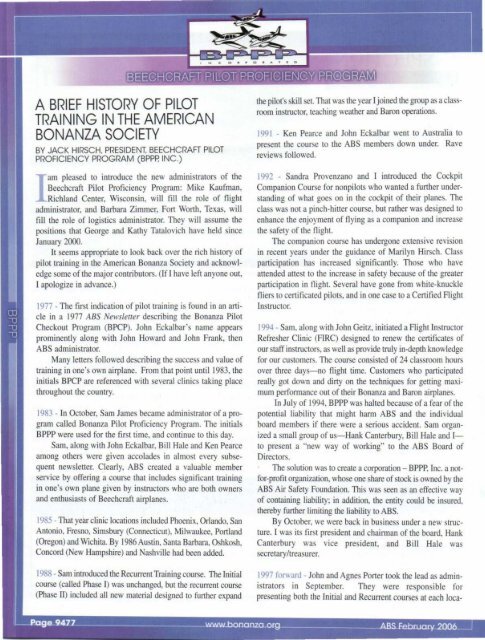Create successful ePaper yourself
Turn your PDF publications into a flip-book with our unique Google optimized e-Paper software.
A BRIEF HISTORY OF PILOTTRAINING IN THE AMERICANBONANZA SOCIETYBY JACK HIRSCH, PRESIDENT. BEECHCRAFT PILOTPROFICIENCY PROGRAM (BPPP. INC.)lam pleased to introduce the new administrators of theBeechcraft Pilot Proficiency Program: Mike Kaufn:an,Richland Center, WlsconslD, will fill the role of flightadministrator, and Barbara Zimmer, Fort Worth, Texas, willfill the role of logistics administrator. They will assume thepositions that George and Kathy Tatalovich have held sinceJanuary 2000.It seems appropriate to look back over the rich history ofpilot training in the <strong>American</strong> <strong>Bonanza</strong> <strong>Society</strong> and acknowledgesome of the major contributors. (If I have left anyone out,I apologize in advance.)1977 - The first indication of pilot training is found in an articlein a 1977 ABS Newsletter describing the <strong>Bonanza</strong> PilotCheckout Program (BPCP), John Eckalbar's name appearspromi nently along with John Howard and John Frank, thenABS administrator.Many !eners followed describing the success and value oftraining in one's own airplane. From that point until 1983, theinitials BPCP are referenced with several clinics taking placethroughout the country.1983 - In October, Sam James became administrator of a programcalled <strong>Bonanza</strong> Pilot Proficiency Program. The initialsBPPP were used for the first time, and continue to this day.Sam, along with John Eckalbar, Bill Hale and Ken Pearceamong others were given accolades in almost every subsequentnewsletter. Clearly, ABS created a valuable memberservice by offering a course that includes significant trainingin one's own plane given by instructors who are both ownersand enthusiasts of Beechcraft airplanes.1985 - That year clinic locations included Phoenix, Orlando, SanAntonio, Fresno, Simsbury (Connecticut), Milwaukee, Portland(Oregon) and Wichita. By 1986 Austin, Santa Barbara, Oshkosh,Concord (New Hampshire) and Nashville had been added.1988 - Sam introduced the Recurrent Training course. The Initialcourse (called Phase I) was unchanged, but the recurrent course(phase m included all new material designed to further expandthe pilot's skill set. That was the year I joined the group as a classroominstructor, teaching weather and Baron operations.1991 - Ken Pearce and John Eckalbar went to Australia topresent the course to the ABS members down under. Ravereviews followed.1992 - Sandra Provenzano and I introduced the CockpitCompanion Course for non pilots who wanted a further understandingof what goes on in the cockpit of their planes. Theclass was not a pinch-hitter course, but rather was designed toenhance the enjoyment of flying as a companion and increasethe safety of the flight.The companion course has undergone extensive revisionin recent years under the guidance of Marilyn Hirsc h. Classparticipation has increased significantl y. Those who haveattended attest to the increase in safety because of the greaterparticipation in flight. Several have gone from white-knucklefliers to certificated pilots, and in one case to a Certified FlightInstructor.1994 - Sam, along with John Geitz, initiated a Flight InstructorRefresher Cl inic (FIRC) designed to renew the certificates ofour staff instructors, as well as provide truly in-depth knowledgefor our customers. The course consisted of 24 classroom hoursover three days-no flight time. Customers who participatedreally got down and dirty on the techniques for getting maximumperformance out of their <strong>Bonanza</strong> and Baron airplanes.In July of 1994, BPPP was halted because of a fear of thepotential liability that might harm ABS and the individualboard members if there were a serious accident. Sam organizeda small group of us-Hank Canterbury, Bill Hale and Ito present a "new way of working" to the ABS Board ofDirectors.The solution was to create a corporation - BPPP, Inc. a notfor-profitorgartization, whose one share of stock is owned by theABS Air Safety Foundation. This was seen as an effective wayof containing liability; in addition, the entity could be insured,thereby further limiting the liability to ABS.By October, we were back in business under a new structure.I was its first president and chairman of the board, HankCanterbury was vice president, and Bill Hale wassecretary!treasurer.1997 forward - John and Agnes Porter took the lead as administratorsin September. They were responsible forpresenting both the Initial and Recurrent courses at each loca-

















